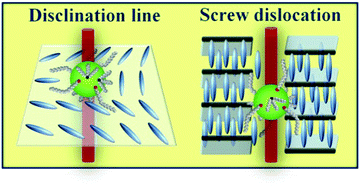Different modulated structures of topological defects stabilized by adaptive targeting nanoparticles
Abstract
It is demonstrated that interactions between

* Corresponding authors
a
Departement Natuurkunde en Sterrenkunde, KU Leuven, 3001 Leuven, Belgium
E-mail:
george.cordoyiannis@ijs.si
b Condensed Matter Physics Department, Jožef Stefan Institute, 1000 Ljubljana, Slovenia
c Department of Physics, University of Athens, 15784 Athens, Greece
d EN FIST Center of Excellence, 1000 Ljubljana, Slovenia
e Department of Physics, University of Maribor, 2000 Maribor, Slovenia
f School of Physics, University of Hyderabad, Hyderabad 500046, Andhra Pradesh, India
g Institute of Materials Science, National Centre for Scientific Research “Demokritos”, 15310 Aghia Paraskevi, Greece
h Biomolecular Physics Laboratory, National Centre for Scientific Research “Demokritos”, 15310 Aghia Paraskevi, Greece
i Jožef Stefan International Postgraduate School, 1000 Ljubljana, Slovenia
j Institute of Inorganic Chemistry, Graz University of Technology, 8010 Graz, Austria
It is demonstrated that interactions between

 Please wait while we load your content...
Something went wrong. Try again?
Please wait while we load your content...
Something went wrong. Try again?
G. Cordoyiannis, V. S. Rao Jampani, S. Kralj, S. Dhara, V. Tzitzios, G. Basina, G. Nounesis, Z. Kutnjak, C. S. Pati Tripathi, P. Losada-Pérez, D. Jesenek, C. Glorieux, I. Muševič, A. Zidanšek, H. Ameinitsch and J. Thoen, Soft Matter, 2013, 9, 3956 DOI: 10.1039/C3SM27644A
To request permission to reproduce material from this article, please go to the Copyright Clearance Center request page.
If you are an author contributing to an RSC publication, you do not need to request permission provided correct acknowledgement is given.
If you are the author of this article, you do not need to request permission to reproduce figures and diagrams provided correct acknowledgement is given. If you want to reproduce the whole article in a third-party publication (excluding your thesis/dissertation for which permission is not required) please go to the Copyright Clearance Center request page.
Read more about how to correctly acknowledge RSC content.
 Fetching data from CrossRef.
Fetching data from CrossRef.
This may take some time to load.
Loading related content
